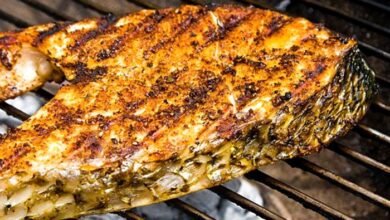How to Make Cassava Chips: A Step-by-Step Guide

Cassava chips, with their satisfying crunch and unique flavor, are a beloved snack in many parts of the world. Making these delectable treats at home is not only a delightful endeavor but also allows you to control the quality and experiment with various seasonings. In this step-by-step guide, we will walk you through the process of making cassava chips from scratch.
EXPLORE THE CONTENTS
What You’ll Need:
Ingredients:
- Fresh cassava roots
- Quality cooking oil (vegetable, canola, or palm oil)
- Salt and your choice of seasonings (e.g., paprika, chili powder, garlic powder)
Equipment:
- A sharp knife or a mandoline slicer
- A large pot for blanching
- A deep fryer or a sturdy pan for frying
- Paper towels or a clean kitchen towel
- A slotted spoon
- A thermometer for monitoring oil temperature
Step 1: Selecting and Preparing Fresh Cassava
- Begin by selecting fresh cassava roots. Look for roots with smooth, firm skin and avoid any that have visible bruises or discolorations. Fresh cassava will result in the best-tasting chips.
- To prepare the cassava for slicing, wash it thoroughly under running water, removing any dirt or debris.
Step 2: Peeling the Cassava
- Using a sharp knife, carefully cut off both ends of the cassava root.
- Make a lengthwise incision along the root, taking care not to cut too deep.
- Gently pry open the incision to remove the tough, outer layer, ensuring that you remove all the woody parts. Be cautious, as cassava can be slippery, and the outer layer may contain a toxic substance that should be discarded.
- Rinse the peeled cassava slices under cold water to remove any remaining debris.
Step 3: Slicing the Cassava into Chips
- The thickness of your cassava slices is crucial for the final result. You can slice them using a knife or a mandoline slicer.
- Aim for uniformity to ensure that the chips cook evenly. Generally, slices that are about 1/8 inch thick work well.
- Remember to exercise caution while slicing, as cassava is firm and can be challenging to cut.
Step 4: Blanching Cassava Slices
- Blanching is an essential step in the cassava chip-making process. It involves briefly cooking the slices in boiling water to soften them and remove some of their starch content, ensuring the chips turn out crispy and not too starchy.
- Fill a large pot with water and bring it to a boil.
- Add the cassava slices to the boiling water and blanch them for 8-10 minutes, or until they become tender but not mushy.
- Use a slotted spoon to remove the blanched cassava slices and place them on paper towels or a clean kitchen towel to remove excess moisture.
Step 5: Drying and Seasoning
- Once blanched, it’s time to dry and season your cassava slices.
- There are various methods for drying, including air-drying, using a dehydrator, or using an oven. The goal is to remove excess moisture.
- After drying, season your chips with salt and your preferred spices. Common choices include chili powder, paprika, or even a touch of garlic for added flavor. Toss the chips gently to ensure even seasoning.
Step 6: Frying Cassava Chips
- To achieve perfectly crispy cassava chips, you’ll need to fry them to a golden brown.
- Heat your cooking oil in a deep fryer or a sturdy pan to around 350°F (175°C). It’s essential to maintain the oil temperature throughout the frying process.
- Carefully add the seasoned cassava slices to the hot oil. Fry them in small batches to prevent overcrowding, which can lower the oil temperature.
- Fry the chips until they turn golden brown and become crisp. This typically takes 3-5 minutes per batch.
- Using a slotted spoon, remove the chips from the hot oil and place them on paper towels to drain any excess oil.
Step 7: Serving and Enjoying
Cassava chips are incredibly versatile and can be enjoyed in various ways:
- As a standalone snack.
- Paired with your favorite dip or sauce.
- As a crunchy topping for salads.
- In creative recipes, such as nachos or cassava chip nachos.
The options are endless, and you can get creative with your serving ideas. Enjoy your homemade cassava chips while they’re fresh and crispy!
Read More: Pistachio Ice Cream:7 Best Pistachio Ice Cream Ideas
Conclusion
In conclusion, making cassava chips at home is a delightful experience that allows you to savor a unique and flavorful snack. With fresh cassava, the right tools, and a bit of patience, you can create these crunchy delights in your own kitchen. Homemade cassava chips not only taste better but also offer the flexibility to experiment with different seasonings and enjoy a satisfying and wholesome snack.
FAQs
1. Can I use frozen cassava to make chips?
- While it’s possible to use frozen cassava, fresh cassava is generally recommended for the best results.
2. Are cassava chips a healthy snack option?
- Cassava chips are a delicious treat but should be enjoyed in moderation due to their high starch content.
3. Can I store cassava chips for later consumption?
- Yes, you can store them in an airtight container to maintain their crispiness.
4. What are some creative seasonings for cassava chips?
- Get creative with seasonings, such as barbecue, sea salt and vinegar, or even cinnamon and sugar for a sweet twist.
5. Can I oven-bake cassava chips instead of frying them?
- Yes, oven-baking is an alternative method that results in slightly healthier cassava chips. Bake them at 350°F (175°C) until they turn golden brown and crispy.







